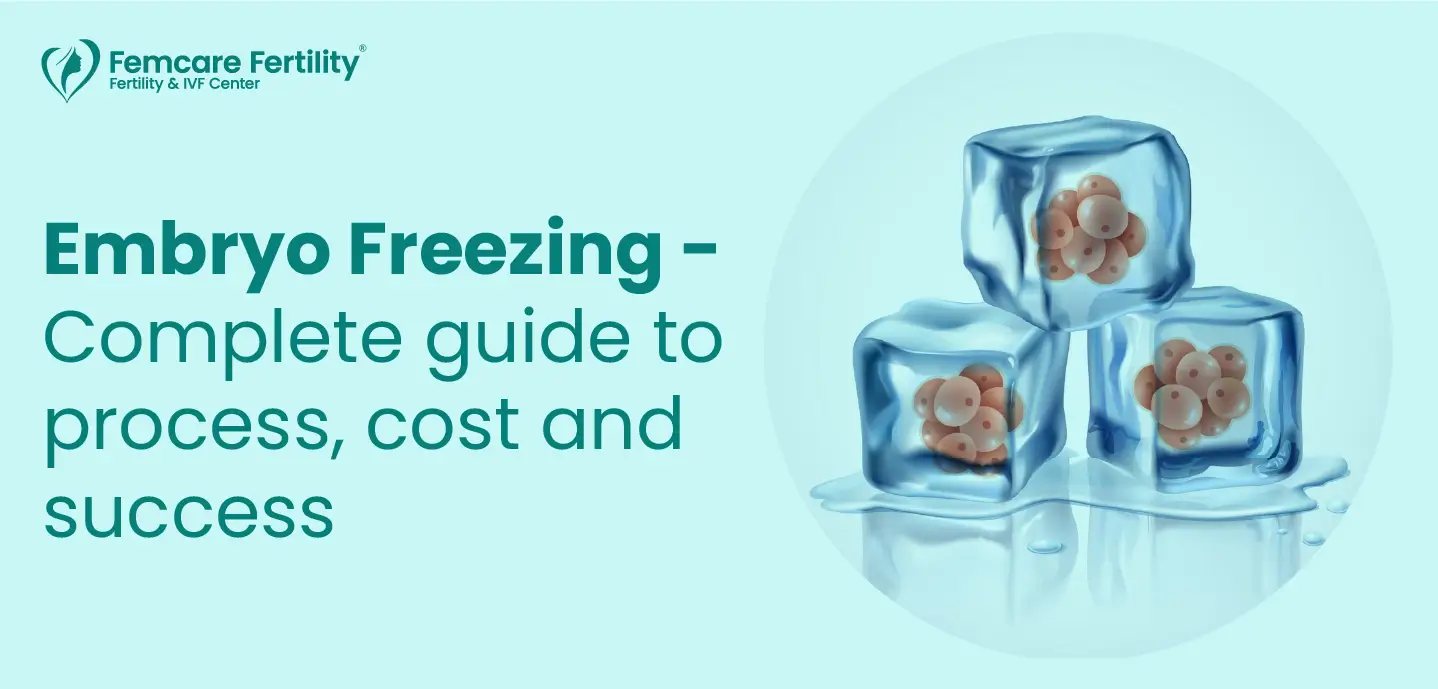Many couples today turn to embryo freezing. In fact, ART clinics reported that around 31% of fresh IVF cycles were freeze-all in 2012, rising to over 40% by 2013. By offering greater flexibility, this approach allows couples to delay pregnancy with peace of mind.
Choosing embryo freezing makes sense for many reasons. Women fight infertility or undergo treatments that harm fertility. Some men or women want fertility preservation before cancer therapy or simply wish to plan pregnancy more conveniently.
Importantly, frozen embryo transfers (FETs) achieve pregnancy rates comparable to fresh transfers, often ranging between 50% and 60%, as supported by clinical studies. This means embryo freezing not only preserves fertility but also offers proven success rates.
Let’s get better insight into the embryo freezing process, costs, duration, and outcomes. You will learn how it works, what you can expect, and why Femcare offers top-notch care.
What is Embryo Freezing & Cryopreservation?
Embryo cryopreservation can be defined as a process of preserving embryos at very low temperatures. Freezing stops biological activity, so clinics store embryos for months or years. Patients benefit because freezing lets them schedule embryo transfers when ready.
At Femcare, professionals freeze embryos using vitrification, a rapid method. Vitrification avoids ice crystals and improves embryo survival during thawing. This technique boosts embryo freezing success rates and makes the process safe and efficient.
The Embryo Freezing Process: Step-by-Step
The process involves multiple steps, like:
- Stimulation and Egg Retrieval: Specialists stimulate egg production with medication. Then, the mature eggs are extracted by the doctors quickly.
- Fertilization and Embryo Culture: Lab experts fertilise eggs using sperm. Then, they culture embryos through key stages such as cleavage and blastocyst formation.
- Freezing (Vitrification): Once embryos reach optimal development, technicians freeze them rapidly via vitrification. This method preserves high embryo viability.
- Storage: Clinics store frozen embryos in liquid nitrogen tanks. You can leave them safely for years.
Throughout the process, specialists monitor embryo stages closely, ensuring personalized care at every step so patients feel supported.
Embryo Freezing Cost & Storage Duration
Embryo freezing costs vary depending on the clinic and services. In India, embryo freezing typically costs INR 20,000 to INR 40,000 per cycle, with annual storage fees ranging from INR 5,000 to INR 45,000; however, pricing can vary depending on various factors. At Femcare, embryologists maintain transparent pricing.
Embryo freezing duration depends on your needs. You may store embryos for months or years. Long-term data show that frozen embryos remain viable even after a decade. Couples have flexibility without sacrificing their chances of pregnancy.
Embryo Freezing Benefits and Success Rates
Benefits
- You preserve fertility proactively.
- Transfers schedule flexibly.
- Saves time and effort in future IVF cycles.
- Embryos can be tested for health before transfer.
- It can protect your fertility before medical treatments like chemotherapy.
- Success rates from frozen embryo transfers now often rival fresh ones.
Success Rates
Data shows a 95% embryo survival rate after thawing. Moreover, the chances of pregnancy with frozen embryos sit around 50–60%, matching fresh cycle outcomes. These numbers illustrate strong embryo freezing success rates. However, the success rate entirely depends on the expertise of the clinic you choose.
What Are The Associated Risks of Embryo Freezing?
- Clinics may discard unused embryos after long storage, so it’s recommended to check policies.
- A small share of embryos may not survive thawing, though vitrification reduces this risk.
Embryo Freezing vs Egg Freezing
Embryo freezing and egg freezing serve similar goals but differ meaningfully.
| Feature | Embryo Freezing | Egg Freezing |
| Fertility Stage | Fertilized embryos | Unfertilized eggs |
| Success Rate | 50-60% Pregnancy chances | Slightly lower than the embryo rate |
| Long-term Outlook | High viability for years | Varies with egg quality |
| Ethical Considerations | Partners consent required | More autonomy for individuals |
So, embryo freezing offers higher success rates. However, egg freezing wins for single individuals or those deciding later about partner involvement.
What Happens After Freezing: Thawing & Transfer
Clinics carefully thaw embryos before proceeding. Technicians use embryo thawing protocols that yield high survival. Then, they transfer viable embryos to the uterus using a simple, short procedure.
Because embryos rest in storage, patients avoid the full stimulation and retrieval cycle again. This convenience reduces cost, emotional stress, and effort. Then, clinics follow up with hormone support and pregnancy monitoring. Fertility preservation becomes an active possibility through one transfer.
How can Femcare assist you with embryo freezing?
Embryo freezing empowers couples to preserve fertility with flexibility, safety, and excellent outcomes. It offers strong pregnancy success, a clear cost structure, and user-friendly logistics. By planning, couples retain control over their fertility journey.
Femcare offers expert embryo freezing services backed by proven survival and pregnancy rates. We focus on human-centred care through every step—from stimulation to thawing. You gain options and confidence when you need them most. Let Femcare help you protect your future with embryo freezing.
FAQs (Frequently Asked Questions)
Question: How Long Can Embryos Stay Frozen?
Answer: Yes, embryo freezing allows embryos to remain viable for a decade or more under proper storage. Clinics often offer long-term plans to safeguard them.
Question: Are Frozen Embryos as Effective as Fresh Ones?
Answer: Yes. Research and results show frozen embryo transfers deliver pregnancy rates similar to fresh cycles, around 50–60%. However success rate can vary.
Question: Does Freezing Harm Embryos?
Answer: No. With advanced embryo vitrification techniques, embryos are preserved safely without affecting their survival. Femcare achieves around 95% survival post-thaw, with minimal risks.
Question: Does Femcare Offer Same-Day Embryo Transfer After Thaw?
Answer: Femcare schedules transfers when your body is ready. Clinics tailor timing based on cycle monitoring, so the process fits your health.
Question: Can Third Parties Use Frozen Embryos?
Answer: Yes, depending on your clinic’s policies. Secondary handling involves ethical and legal considerations, so staff can guide you carefully.
